River Aire
| River Aire | |
| River | |
 The River Aire at Gargrave, North Yorkshire | |
| Country | England |
|---|---|
| Counties | North Yorkshire, West Yorkshire, East Riding of Yorkshire |
| District | Craven |
| Tributaries | |
| - left | Gordale Beck, Eshton Beck, Eller Beck, Silsden Beck |
| - right | Otterburn Beck, Broughton Beck, Eastburn Beck, River Worth, Harden Beck, Bradford Beck, River Calder |
| City | Leeds |
| Source | |
| - location | streams above Malham Tarn, North Yorkshire |
| - elevation | 405 m (1,329 ft) |
| - coordinates | 54°05′49″N 2°11′27″W / 54.0969°N 2.1907°W |
| Mouth | River Ouse |
| - location | Airmyn, East Riding of Yorkshire |
| - elevation | 5 m (16 ft) |
| - coordinates | 53°43′38″N 0°54′24″W / 53.7272°N 0.9067°WCoordinates: 53°43′38″N 0°54′24″W / 53.7272°N 0.9067°W |
| Length | 148 km (92 mi) |
| Basin | 1,004 km2 (388 sq mi) |
| Discharge | for River Ouse |
| - average | 35.72 m3/s (1,261 cu ft/s) |
| River Aire | |||||||||||||||||||||||||||||||||||||||||||||||||||||||||||||||||||||||||||||||||||||||||||||||||||||||||||||||||||||||||||||||||||||||||||||||||||||||||||||||||||||||||||||||||||||||||||||||||||||||||||||||||||||||||||||||||||||||||||||||||||||||||||||||||||||||||||||||||||||||||||||||||||||||||||||||||||||||||||||||||||||||||||||||||||||||||||||||||||||||||||||||||||||||||||||||||||||||||||||||||||||||||||||||||||||||||||||||||||||||||||||||||||||||||||||||||||||||||||||||||||||||||||||||||||||||||||||||||||||||||||||||||||||||||||||||||||||||||||||||||||||||||||||||||||||||||||||||||||||||||||||||||||||||||||||||||||||||||||||||||||||||||||||||||||||||||||||||||||||||||||||||||||||||||||||||||||||||||||||||||||||||||||||||||||||||||||||||||||||||||||||||||||||||||||||||||||||||||||||||||||||||||||||||||||||||||||||||||||||||||||||||||||||||||||||||||||||||||||||||||||||||||||||||||||||||||||||||||||||||||||||||||||||||||||||||||||||||||||||||||||||||||||||||||||||||||||||||||||||||
|---|---|---|---|---|---|---|---|---|---|---|---|---|---|---|---|---|---|---|---|---|---|---|---|---|---|---|---|---|---|---|---|---|---|---|---|---|---|---|---|---|---|---|---|---|---|---|---|---|---|---|---|---|---|---|---|---|---|---|---|---|---|---|---|---|---|---|---|---|---|---|---|---|---|---|---|---|---|---|---|---|---|---|---|---|---|---|---|---|---|---|---|---|---|---|---|---|---|---|---|---|---|---|---|---|---|---|---|---|---|---|---|---|---|---|---|---|---|---|---|---|---|---|---|---|---|---|---|---|---|---|---|---|---|---|---|---|---|---|---|---|---|---|---|---|---|---|---|---|---|---|---|---|---|---|---|---|---|---|---|---|---|---|---|---|---|---|---|---|---|---|---|---|---|---|---|---|---|---|---|---|---|---|---|---|---|---|---|---|---|---|---|---|---|---|---|---|---|---|---|---|---|---|---|---|---|---|---|---|---|---|---|---|---|---|---|---|---|---|---|---|---|---|---|---|---|---|---|---|---|---|---|---|---|---|---|---|---|---|---|---|---|---|---|---|---|---|---|---|---|---|---|---|---|---|---|---|---|---|---|---|---|---|---|---|---|---|---|---|---|---|---|---|---|---|---|---|---|---|---|---|---|---|---|---|---|---|---|---|---|---|---|---|---|---|---|---|---|---|---|---|---|---|---|---|---|---|---|---|---|---|---|---|---|---|---|---|---|---|---|---|---|---|---|---|---|---|---|---|---|---|---|---|---|---|---|---|---|---|---|---|---|---|---|---|---|---|---|---|---|---|---|---|---|---|---|---|---|---|---|---|---|---|---|---|---|---|---|---|---|---|---|---|---|---|---|---|---|---|---|---|---|---|---|---|---|---|---|---|---|---|---|---|---|---|---|---|---|---|---|---|---|---|---|---|---|---|---|---|---|---|---|---|---|---|---|---|---|---|---|---|---|---|---|---|---|---|---|---|---|---|---|---|---|---|---|---|---|---|---|---|---|---|---|---|---|---|---|---|---|---|---|---|---|---|---|---|---|---|---|---|---|---|---|---|---|---|---|---|---|---|---|---|---|---|---|---|---|---|---|---|---|---|---|---|---|---|---|---|---|---|---|---|---|---|---|---|---|---|---|---|---|---|---|---|---|---|---|---|---|---|---|---|---|---|---|---|---|---|---|---|---|---|---|---|---|---|---|---|---|---|---|---|---|---|---|---|---|---|---|---|---|---|---|---|---|---|---|---|---|---|---|---|---|---|---|---|---|---|---|---|---|---|---|---|---|---|---|---|---|---|---|---|---|---|---|---|---|---|---|---|---|---|---|---|---|---|---|---|---|---|---|---|---|---|---|---|---|---|---|---|---|---|---|---|---|---|---|---|---|---|---|---|---|---|---|---|---|---|---|---|---|---|---|---|---|---|---|---|---|---|---|---|---|---|---|---|---|---|---|---|---|---|---|---|---|---|---|---|---|---|---|---|---|---|---|---|---|---|---|---|---|---|---|---|---|---|---|---|---|---|---|---|---|---|---|---|---|---|---|---|---|---|---|---|---|---|---|---|---|---|---|---|---|---|---|---|---|---|---|---|---|---|---|---|---|---|---|---|---|---|---|---|---|---|---|---|---|---|---|---|---|---|---|---|---|---|---|---|---|---|---|---|---|---|---|---|---|---|---|---|---|---|---|---|---|---|---|---|---|---|---|---|---|---|---|---|---|---|---|---|---|---|---|---|---|---|---|---|---|---|---|---|---|---|---|---|---|---|---|---|---|---|---|---|---|---|---|---|---|---|---|---|---|---|---|---|---|---|---|---|---|---|---|---|---|---|---|---|---|---|---|---|---|---|---|---|---|---|---|---|---|---|---|---|---|---|---|---|---|---|---|---|---|---|---|---|---|---|---|---|---|---|---|---|---|---|---|---|---|---|---|---|---|---|---|---|---|---|---|---|---|---|---|---|---|---|---|---|---|---|---|---|---|---|---|---|---|---|---|---|---|---|---|---|---|---|---|---|---|---|---|---|---|---|---|---|---|---|---|---|---|---|---|---|---|---|---|---|---|---|---|---|---|---|---|---|---|---|---|---|---|---|---|---|---|---|---|---|---|---|---|---|---|---|---|---|---|---|---|---|---|---|---|---|---|---|---|---|---|---|---|---|---|---|---|---|---|---|---|---|---|---|---|---|---|---|---|---|---|---|---|---|---|---|---|---|---|---|---|---|---|---|---|---|---|---|---|---|---|---|---|---|---|---|---|---|---|---|---|
| |||||||||||||||||||||||||||||||||||||||||||||||||||||||||||||||||||||||||||||||||||||||||||||||||||||||||||||||||||||||||||||||||||||||||||||||||||||||||||||||||||||||||||||||||||||||||||||||||||||||||||||||||||||||||||||||||||||||||||||||||||||||||||||||||||||||||||||||||||||||||||||||||||||||||||||||||||||||||||||||||||||||||||||||||||||||||||||||||||||||||||||||||||||||||||||||||||||||||||||||||||||||||||||||||||||||||||||||||||||||||||||||||||||||||||||||||||||||||||||||||||||||||||||||||||||||||||||||||||||||||||||||||||||||||||||||||||||||||||||||||||||||||||||||||||||||||||||||||||||||||||||||||||||||||||||||||||||||||||||||||||||||||||||||||||||||||||||||||||||||||||||||||||||||||||||||||||||||||||||||||||||||||||||||||||||||||||||||||||||||||||||||||||||||||||||||||||||||||||||||||||||||||||||||||||||||||||||||||||||||||||||||||||||||||||||||||||||||||||||||||||||||||||||||||||||||||||||||||||||||||||||||||||||||||||||||||||||||||||||||||||||||||||||||||||||||||||||||||||||||
The River Aire is a major river in Yorkshire, England, 148 kilometres (92 mi) in length.[1] The Handbook for Leeds and Airedale (1890) notes that the distance from Malham to Howden is 58 miles (93 km) direct, but the river's meanderings extend that to 90 miles (140 km).[2] Between Malham Tarn and Airmyn, the river drops 400 metres (1,300 ft).[3] Part of the river below Leeds is canalised, and is known as the Aire and Calder Navigation.
Course
The Aire starts its journey at Malham Tarn. It becomes a subterranean stream at 'Water Sinks' about 1 mile (1.6 km) before the top of Malham Cove, it then flows underground to Aire Head, just below Malham, in North Yorkshire, and then flows through Gargrave and Skipton. After Cononley, the river enters West Yorkshire where it passes through the former industrial areas of Keighley, Bingley, Saltaire and Shipley. It then passes through Leeds and on to the villages of Swillington and Woodlesford. At Castleford is the confluence of the Aire and Calder; just downstream of the confluence was the ford where the ancient British road, used by the Romans, crossed on its way north to York. The river re-enters North Yorkshire near Knottingley and in its lower reaches forms part of the boundary between North Yorkshire and the East Riding of Yorkshire.
Tests have been conducted to authenticate the actual source of the Aire. The tarn at Malham has been dammed and then allowed to flood. Observers have noted that whilst water surged at Aire Head, it also surged at the bottom of Malham Cove. There was a significant difference of 30 minutes between the two surges with Malham Cove being slower to react to the floodwater.[4]
The section between Malham Tarn and the confluence of the becks at Aire Head is known as Malhamdale.[5] Thereafter the valley is known as Airedale and encompasses Bradford, (even though the river bypasses the city) and by the time it reaches Leeds, the term Airedale is rarely applied.[6]
The River Aire empties into the River Ouse at Airmyn, 'myn' being an old English word for 'river mouth'.[7]
Settlements
from source
- Malham
- Hanlith
- Airton
- Bell Busk
- Gargrave
- Skipton
- Low Bradley
- Cononley
- Kildwick
- Silsden
- Steeton
- Utley
- Keighley
- Riddlesden
- Crossflatts
- Bingley
- Saltaire
- Shipley
- Charlestown
- Esholt
- Apperley Bridge
- Horsforth
- Kirkstall
- Leeds city centre
- Holbeck
- Knowsthorpe
- Allerton Bywater
- Castleford
- Brotherton
- Ferrybridge
- Knottingley
- Beal
- West Haddlesey
- Chapel Haddlesey
- Temple Hirst
- Hensall
- Gowdall
- Snaith
- Rawcliffe
- Newland
- Airmyn
(Joins River Ouse)
Toponymy
The name Yr is documented in Gray's Cartularium Saxonicum in 959 AD. The river is darcy and ðarcy (with the ancient eth) in 963, in the same source. It is Eyr’ in 1135 in The Coucher Book of Selby and other sources up to 1298. Eir is given in 1175-7 in one of the Dodsworth Manuscripts in Farrer's Early Yorkshire Charters. Air from c. 1160 to 1577, Air’ in the thirteenth century.[8] In John Cossins' 1775 Plan of the Town of Leedes it is labelled "River Air".[9] In 1857 it was proposed that the name Aire may be from Common Brittonic *Isara, meaning "strong river".[10][11]
History
The deposit of silt by two tributaries close together, the Meanwood Beck from the north and the Hol Beck from the south led to a crossing place and a settlement which eventually became the town of Leeds.[12] The Aire was forded by a paved way by the Romans at Castleford as part of a road connecting Doncaster with York which went north through the town near to the church.[13][14] At this time, the River Don emptied into the Aire at Snaith, but the Dutch engineer, Cornelius Vermuyden, changed the course of the Don in the 1630s so that it flows into the Ouse after its confluence with the Aire.[15]
During the Great Frost of 1683–84 the river froze solid for a month allowing a fair with an ox-roast and sports to take place, as described by Ralph Thoresby.[12]
An Act of Parliament was passed in 1699 to make the river downstream of Leeds navigable (the Aire and Calder Navigation) with a further act to extend the navigable part of the river upstream to Bingley. This second act formed the basis of the Leeds and Liverpool Canal.[16]
Between the middle part of the nineteenth century to the latter part of the twentieth, the River Aire was devoid of fish life downstream of Shipley due to its pollution. Efforts have been made to return the river to a good wildlife status and fish and other wildlife now do exist all along the course of the river.[17]
Power stations
There are three thermal power stations alongside the River Aire east of Castleford; Ferrybridge C, Eggborough[18] and Drax. Drax takes its cooling water from the Ouse, but both Ferrybridge and Eggborough draw their water from the Aire. Both of these plants stopped generating in 2016,[19] with Eggborough being a stand-by for capacity problems until March 2017.[20]
A hydroelectric power station was installed on the Brotherton Weir at Knottingley in November 2017. The £7.5 million project is expected to deliver 500 kilowatts per year and be operational for 100 years.[21][22][23]
Ecology
Due to the Aire flowing through the former industrial landscape of West Yorkshire, it had a reputation as being heavily polluted.[24] In 2007, Yorkshire Water carried out improvements to Esholt Sewage Works at a cost of £110 million under the EU's Fresh Water Fish Directive. Whilst Trout are prevalent above Keighley, the river is host to others such as Chub, Dace, Barbel & Grayling, whilst Sea Trout have been noted as far upriver as Shipley.[25] Work is also being undertaken to make the many weirs on the river easier to negotiate for fish.[26] These improvements have also allowed Otters and Water Voles to return to the river as the water and food quality is far superior to that when the river was polluted.[27]
Castleford Wastewater Treatment Works has had £16 million of investment between 2013 and 2015. The improvements to this plant, which discharges water directly into the Aire, has also vastly improved water quality downstream of the plant.[25]
Rodley Nature Reserve, Kirkstall Valley Nature Reserve, St Aidans and Fairburn Ings RSPB reserve all lie alongside the Aire.
Navigation
The Aire is navigable as far upstream as Leeds and downstream has a navigable section into the Aire & Calder Navigation, with navigable access to other canals and waterways. Crown Point in Leeds is listed as the furthest west that can be reached by boat, though the limit is a headroom of 11 feet 11 inches (3.62 m).[28] The weir that straddles Crown Point is a listed structure having been constructed in medieval times and first documented in 1636.[29]
Canoeing and rowing are popular sports on the river with at least two clubs (the Bradford and Bingley Canoe Club and the Bradford Amateur Rowing Club) having landings on the river. Canoeing can be carried out on most parts of the river, with the two clubs having navigable sections protected by weirs next to their landings.[30][31]
Gallery
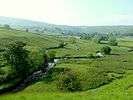 South of Malham
South of Malham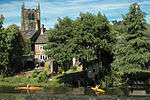

 The 2008 bridge over the River Aire at Castleford
The 2008 bridge over the River Aire at Castleford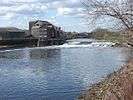
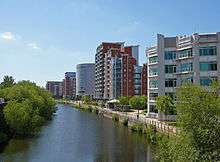 River Aire at Leeds
River Aire at Leeds
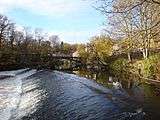 Pollard Bridge, Newlay near Leeds
Pollard Bridge, Newlay near Leeds The River Aire as it approaches the River Ouse at Airmyn
The River Aire as it approaches the River Ouse at Airmyn The confluence of the River Aire and River Ouse. The Aire emerges from the left.
The confluence of the River Aire and River Ouse. The Aire emerges from the left.
See also
References
- ↑ "River Aire Factfile" (PDF). Environment Data. Environment Agency. p. 2. Retrieved 15 November 2016.
- ↑ Miall 1890, p. 40.
- ↑ Speight, Harry (1891). "Table of altitudes". Through Airedale from Goole to Malham. Leeds: Walker Laycock. p. ixiv. OCLC 5824116.
- ↑ Miall 1890, p. 3.
- ↑ "Strategic Flood Risk Assessment" (PDF). North Yorkshire County Council. p. 9. Retrieved 15 November 2016.
- ↑ Ayto, John; Crofton, Ian (2005). Brewers Britain & Ireland. London: Weidenfeld & Nicolson. p. 14. ISBN 0-304-35385-X.
- ↑ Ekwall, Eilert. The concise Oxford dictionary of English place-names (4 ed.). Oxford: Clrendon Press. p. 4. OCLC 400936.
- ↑ Eilert Ekwall (1928). English River Names. OUP. p. 1.
- ↑ Brian Godward (2004) The Changing Face of Leeds (Sutton Publishing,Stroud) ISBN 0-7509-3413-1
- ↑ "A Brief History of the Fairburn Area". Web.onetel.net.uk. Retrieved 5 August 2011.
- ↑ Archaeologia Aeliana, Or, Miscellaneous Tracts Relating to Antiquity By Society of Antiquaries of Newcastle upon Tyne Published by Society of Antiquaries of Newcastle upon Tyne, 1857 Item notes: ns.1 Original from Oxford University Digitized 24 January 2007
- 1 2 W. R. Mitchell (2000) A History of Leeds Phillimore, West Sussex, ISBN 1 86077 130 0
- ↑ Speight, Harry (1891). "Table of altitudes". Through Airedale from Goole to Malham. Leeds: Walker Laycock. p. 39. OCLC 5824116.
- ↑ "Roman Castleford" (PDF). Wakefield.gov.uk. p. 2. Retrieved 14 November 2016.
- ↑ Miall 1890, p. 39.
- ↑ "River Aire". Canal & River Trust. Retrieved 15 November 2016.
- ↑ "Kirkstall Valley Weir Fish Passes" (PDF). Aire Rivers Trust. Retrieved 15 November 2016.
- ↑ "Lubrafil" (PDF). Archived from the original (PDF) on 4 March 2016.
- ↑ "Ferrybridge C Power Station officially closes after 50 years". BBC News. 31 March 2016. Retrieved 15 November 2016.
- ↑ "Reprieve for threatened Eggborough Power Station". BBC News. 8 February 2016. Retrieved 15 November 2016.
- ↑ "Harnessing power for a new generation from Yorkshire's rivers". The Yorkshire Post. 14 March 2017. Retrieved 10 January 2018.
- ↑ Charlesworth, Ricky (3 November 2017). "VIDEO: £7.5m Knottingley hydroelectric plant to produce a 'century worth of power'". The Yorkshire Post. Retrieved 10 January 2018.
- ↑ "Hydroelectric £7.5m power station opens". BBC News. 4 November 2017. Retrieved 10 January 2018.
- ↑ "A brief history of the River Aire". Aire Rivers Trust. Retrieved 24 November 2015.
- 1 2 "Waste Water". Yorkshire Water. Retrieved 21 October 2015.
- ↑ "River Water Quality". Yorkshire Water. Retrieved 21 October 2015.
- ↑ "Pollution is water under the bridge". Keighley News. Retrieved 20 October 2015.
- ↑ "Canal & River Trust - Aire & Calder Canal" (PDF).
- ↑ Historic England. "Leeds dam on River Aire (1375063)". National Heritage List for England. Retrieved 15 November 2016.
- ↑ White, Clive (7 April 2010). "Bingley canoeists are going for gold". Telegraph & Argus. Retrieved 15 November 2016.
- ↑ "Home". Bradford Amateur Rowing Club. Retrieved 15 November 2016.
Bibliography
External links
| Wikimedia Commons has media related to River Aire. |